What are we going to see?
Our aim is to bring life in the open waters closer to the general public and for you to get to know, at first hand, the fauna that inhabits this environment. The oceanic or pelagic waters constitute an immense ecosystem, which begins where the continental shelf ends.
Here, the depth is around 200 metres and quickly reaches depths of thousands of metres. The water column is inhabited by a large number of species, many of them unknown to the vast majority of us. It is a magical environment, where the hours pass quickly, due to the excitement of not knowing what is going to appear before us.
Below we show you the species that we see during our outings in the Big Blue, from the most common to the most difficult to see.
The most common
Blue shark (Prionace glauca)
This shark, which is the star of our trips, belongs to the Carcharhinidae family.
With a pelagic life, it lives all over the ocean, where it carries out large migrations. In our waters we can find from individuals of around 60 cm to adults of more than 2.5 m, although individuals of approximately 1.5 m are the most common.
With a stylised and elongated body, it has an intense blue colour on its back, from which it gets its name. Its belly is white. It is a shark that can be found relatively easily. In general, they show a rather shy behaviour, being quite elusive.
Only after staying for a long time with them, undisturbed, they start to lose their shyness and can come closer.
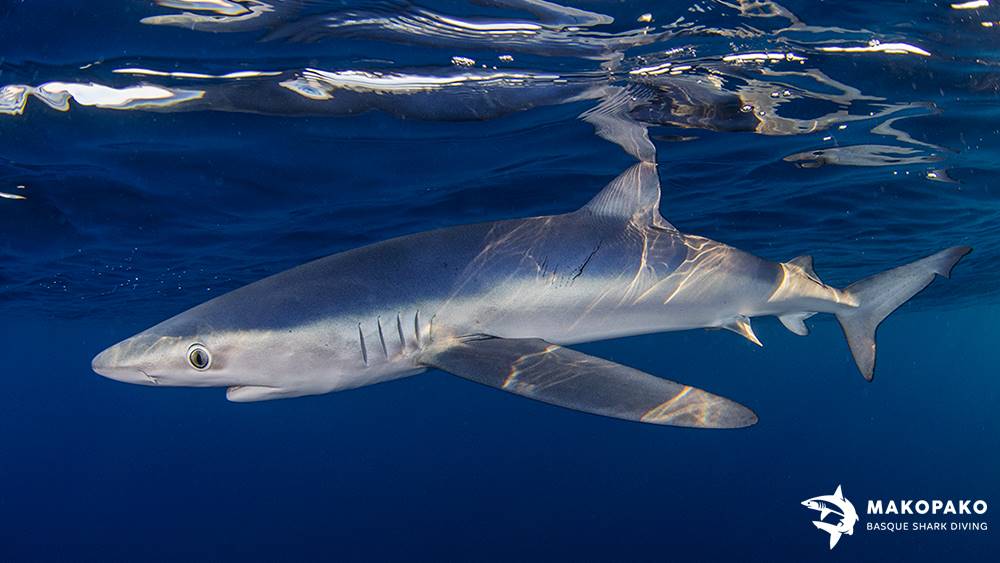
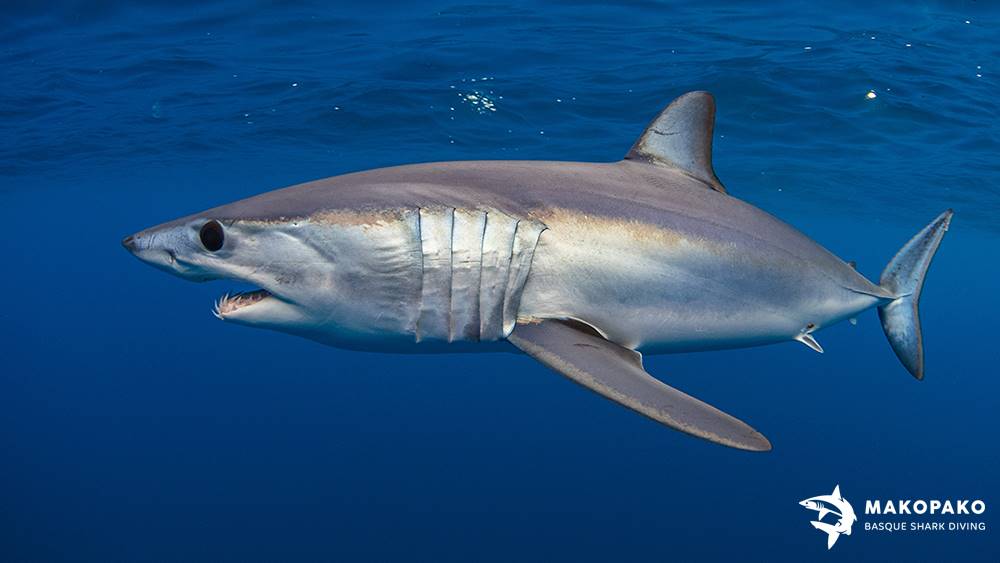
Shortfin Mako Shark (Isurus oxyrinchus)
Seeing a shortfin mako shark may be one of the most special encounters you can have underwater. It is a solitary shark and difficult to see. They are usually fleeting encounters, not staying long in the area. It is a very scarce shark, with a very low reproductive rate and very threatened by overfishing. It is in critical danger of extinction, hence the difficulty and special nature of being able to observe it.
It belongs to the Lamnidae family, like the white shark, with which it bears a marked resemblance. With a robust body, it is a powerful swimmer, being the fastest shark in existence.
Plankton (phytoplankton and zooplankton)
Plankton is made up of phytoplankton (photosynthetic organisms) and zooplankton (heterotrophic animals) and consists of thousands of different species. It is a rare day when it is not present; although at first it may go unnoticed, if you stop to observe, you will discover a myriad of small particles suspended in the water.
You will see that these “micro-beings” come in many different shapes, from the simplest to the most whimsical. With a bit of luck, you might even spot a “micro-medusa” or something tiny that reminds you of a shrimp.
Although we often pay little attention to them, plankton form the base of the ocean’s food chain.
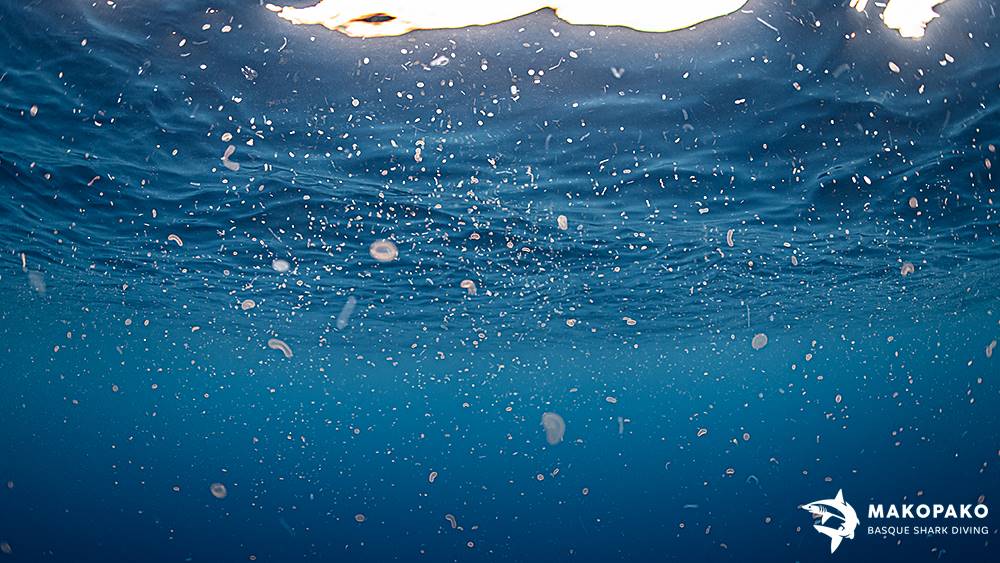
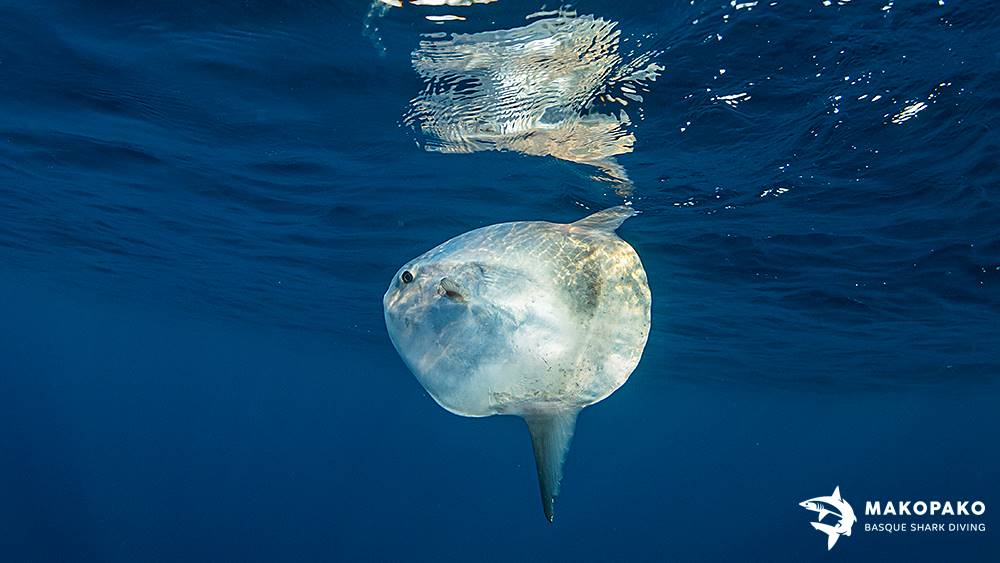
Sunfish (Mola mola)
This unusual-looking fish is the largest bony fish in the world. It can grow up to 3 m in length and weigh up to 1000 kg, although the ones we usually see are much smaller, around 30-50 cm.
They are usually solitary, although we have also seen groups of up to 10-15 individuals.
They are easily recognisable by their markedly rounded silhouette and their characteristic upper and lower fins. They are animals that swim calmly and slowly and it is common to see them jumping out of the water 3 or 4 times in a row.
They are also accustomed to approach seagulls resting on the surface to be wormed with their beaks. It is a clear example of symbiosis, in which both species are favoured.
Salps (Pegea confoederata)
Of all the small organisms that we find in the ocean travelling with the currents, this is one of the most striking. Because of its gelatinous appearance, the first thing that comes to mind when we see it is a jellyfish; although, in reality, it is a chordate, evolutionarily closer to humans than to jellyfish.
It can be seen as a solitary individual, or, more commonly, forming colonies of several individuals fused together. There are many curiosities we can tell you about this animal, but one of the most relevant nowadays is the role it plays as a CO2 sink in the oceans. They feed on a large amount of phytoplankton and all this carbon is trapped on the seabed in the form of dead bodies and faeces.
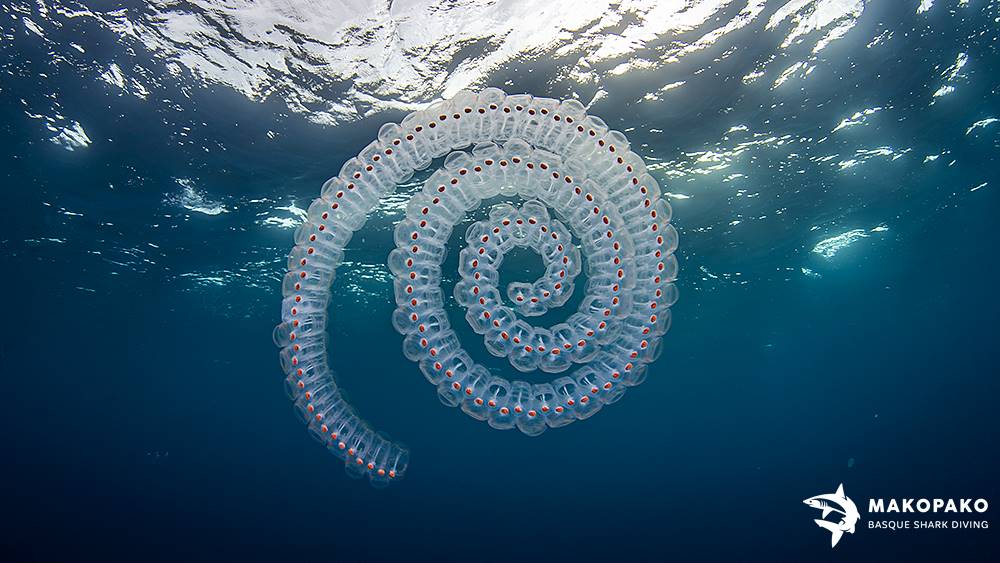
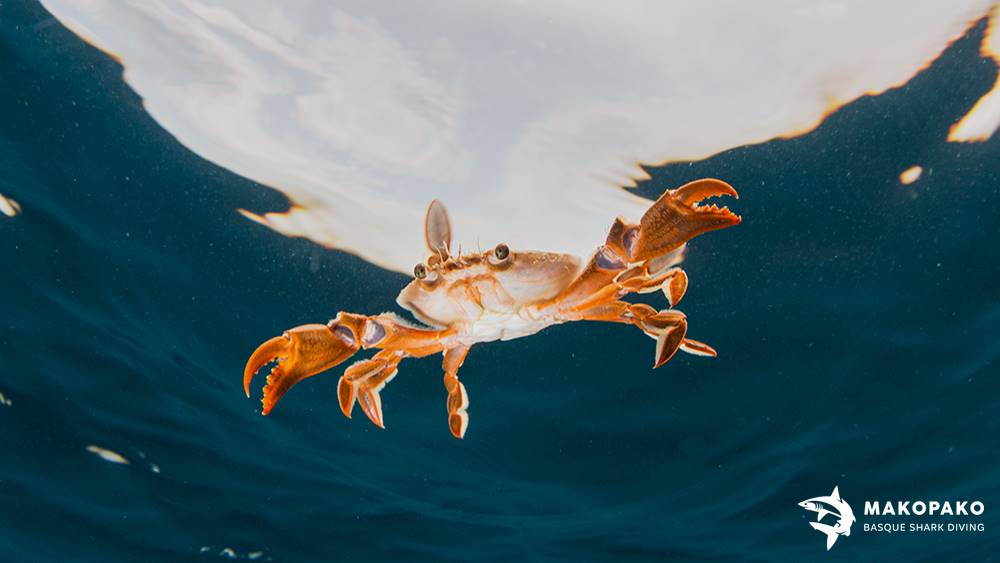
Sardine swimming crab (Polybius henslowii)
Although this small and friendly crab can be seen close to the coast, it can sometimes be found in oceanic waters, swimming in the middle of the immensity. On certain occasions they can be seen in very large numbers.
It is an animal with a strong character and does not hesitate to raise its claws as a warning if you come too close; it is always alert, as in the pelagic environment it is an important source of food for many animals, especially yellow-legged gulls.
Jellyfish aequorea (Aequorea forskalea)
This species of jellyfish is the most commonly seen and can be found in the blue throughout the season. Easily recognisable due to its simplicity, with the umbrella and the not very long tentacles hanging from it.
Despite its appearance and the fact that it is a jellyfish, it is not stinging for humans.
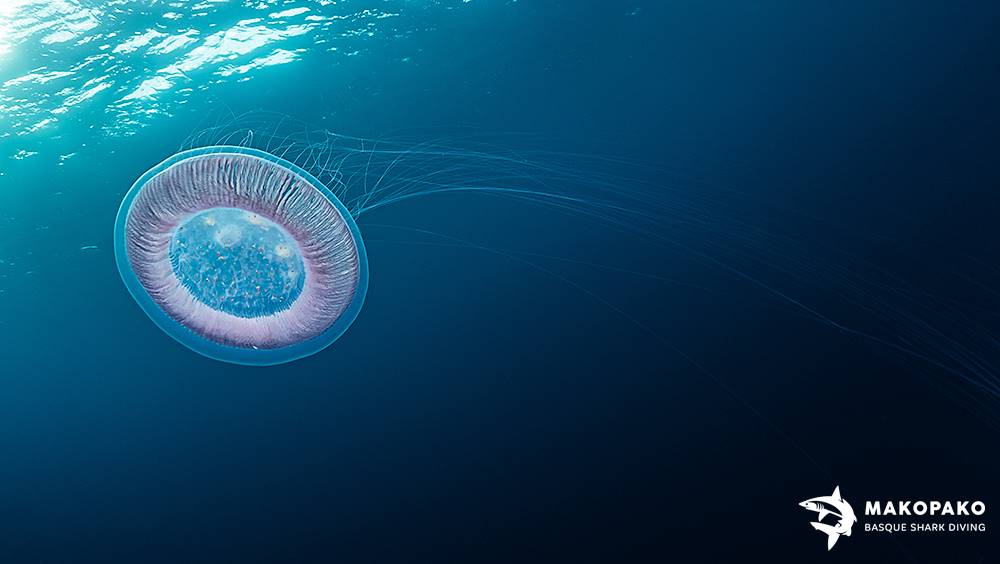
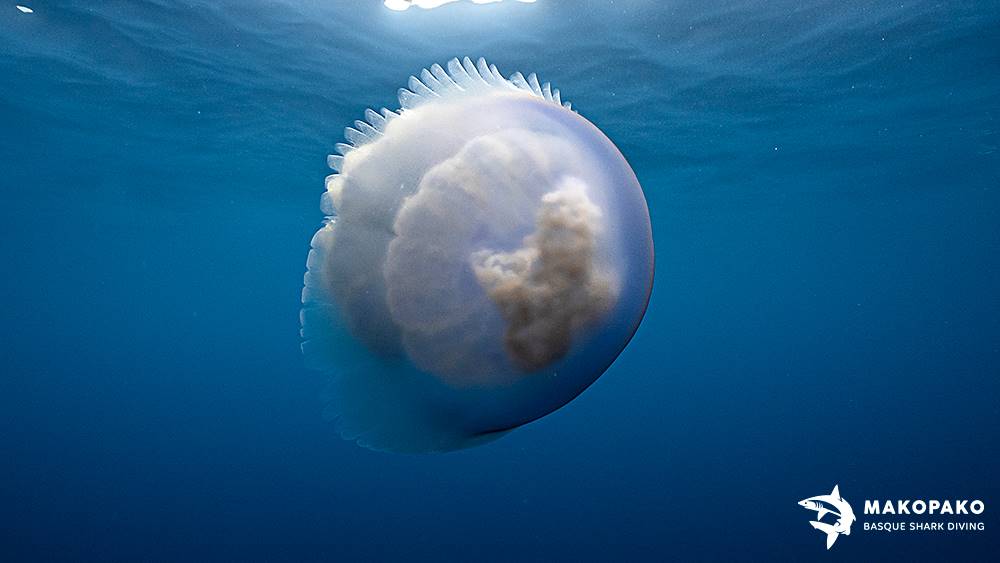
Barrel jellyfish (Rhizostoma pulmo)
With the classic appearance of a jellyfish, this is usually seen from the end of August and generally extends throughout September.
It is characterised by a large, light-coloured umbrella with white, yellow or pinkish tones and a blue border.
It has no tentacles, but 8 rather thick arms. It is sometimes accompanied by one or more small cicadas and is not dangerous to humans.
Mauve stinger (Pelagia noctiluca)
This small pink or purple jellyfish is also common on the coast.
If you see it, you have to be a little careful with it. Although it is not a big problem, contact with its tentacles can cause irritation and itching.
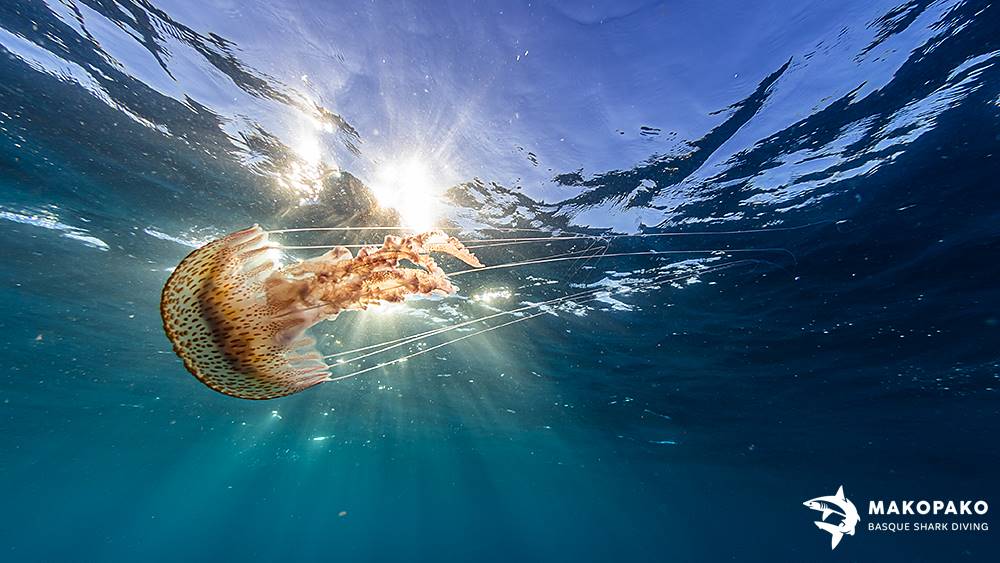
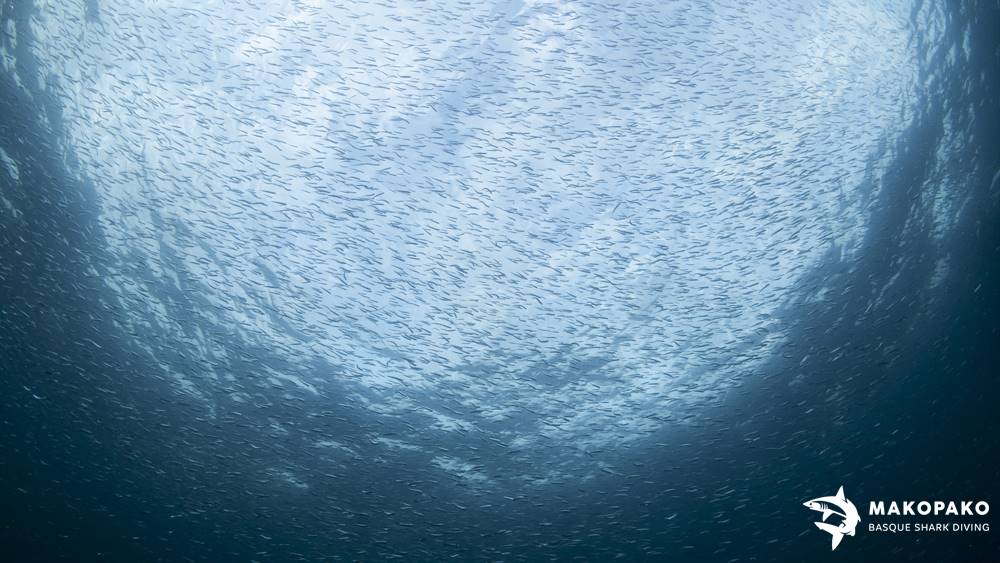
Anchovy (Engraulis encrasicolus)
The well-known Cantabrian anchovy is one of the most important sources of food for many of the animals that inhabit these waters, not forgetting the very high value it has for humans.
Occasionally, shoals of these fish in their juvenile phase, approximately 7 cm in size, approach the boat. They can be distinguished as small flashes of light, due to the reflection of the rays on their small bodies.
Pelagic stingray (Pteroplatytrygon violacea)
There are around 600 different species of stingrays worldwide, and they are distributed in both salt and fresh water. Most of them live in association with the bottom, although this particular species spends most of its life in open water, swimming close to the surface.
It is not an animal that we see very often, but they can be seen between 4 or 5 times per season.
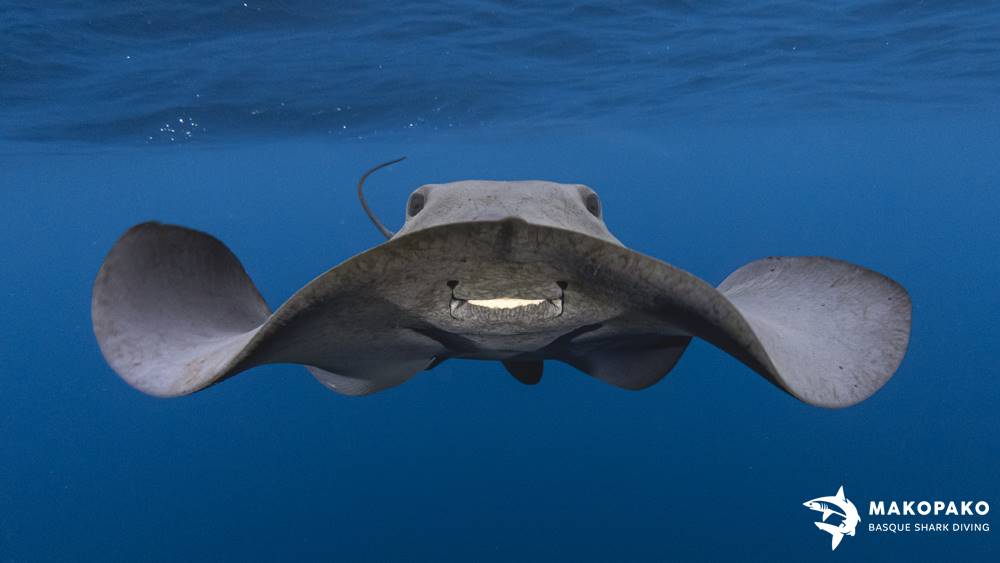
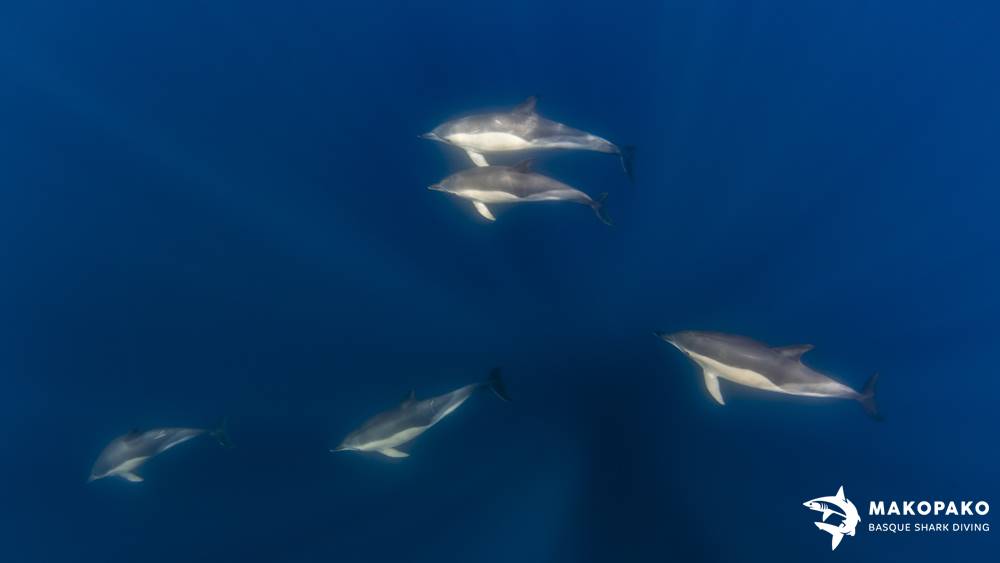
Common dolphin (Delphinus delphis)
We are always happy to see dolphins and people are surprised when they come our way, as it is something you don’t expect. We see them relatively often during boat trips, as they like to jump on the waves produced by the boat as it moves.
They are very easily recognisable, due to their small size and the fact that when they jump, you can distinguish the characteristic hourglass-shaped spot that makes up their light shades on the belly and the dark grey colour of the back.

Blue shark (Prionace glauca)
This shark, which is the star of our trips, belongs to the Carcharhinidae family.
With a pelagic life, it lives all over the ocean, where it carries out large migrations. In our waters we can find from individuals of around 60 cm to adults of more than 2.5 m, although individuals of approximately 1.5 m are the most common.
With a stylised and elongated body, it has an intense blue colour on its back, from which it gets its name. Its belly is white. It is a shark that can be found relatively easily. In general, they show a rather shy behaviour, being quite elusive.
Only after staying for a long time with them, undisturbed, they start to lose their shyness and can come closer.

Shortfin Mako Shark (Isurus oxyrinchus)
Seeing a shortfin mako shark may be one of the most special encounters you can have underwater. It is a solitary shark and difficult to see. They are usually fleeting encounters, not staying long in the area. It is a very scarce shark, with a very low reproductive rate and very threatened by overfishing. It is in critical danger of extinction, hence the difficulty and special nature of being able to observe it.
It belongs to the Lamnidae family, like the white shark, with which it bears a marked resemblance. With a robust body, it is a powerful swimmer, being the fastest shark in existence.

Plankton (phytoplankton and zooplankton)
Plankton is made up of phytoplankton (photosynthetic organisms) and zooplankton (heterotrophic animals) and consists of thousands of different species. It is a rare day when it is not present; although at first it may go unnoticed, if you stop to observe, you will discover a myriad of small particles suspended in the water.
You will see that these “micro-beings” come in many different shapes, from the simplest to the most whimsical. With a bit of luck, you might even spot a “micro-medusa” or something tiny that reminds you of a shrimp.
Although we often pay little attention to them, plankton form the base of the ocean’s food chain.

Sunfish (Mola mola)
This unusual-looking fish is the largest bony fish in the world. It can grow up to 3 m in length and weigh up to 1000 kg, although the ones we usually see are much smaller, around 30-50 cm.
They are usually solitary, although we have also seen groups of up to 10-15 individuals.
They are easily recognisable by their markedly rounded silhouette and their characteristic upper and lower fins. They are animals that swim calmly and slowly and it is common to see them jumping out of the water 3 or 4 times in a row.
They are also accustomed to approach seagulls resting on the surface to be wormed with their beaks. It is a clear example of symbiosis, in which both species are favoured.

Salps (Pegea confoederata)
Of all the small organisms that we find in the ocean travelling with the currents, this is one of the most striking. Because of its gelatinous appearance, the first thing that comes to mind when we see it is a jellyfish; although, in reality, it is a chordate, evolutionarily closer to humans than to jellyfish.
It can be seen as a solitary individual, or, more commonly, forming colonies of several individuals fused together. There are many curiosities we can tell you about this animal, but one of the most relevant nowadays is the role it plays as a CO2 sink in the oceans. They feed on a large amount of phytoplankton and all this carbon is trapped on the seabed in the form of dead bodies and faeces.

Sardine swimming crab (Polybius henslowii)
Although this small and friendly crab can be seen close to the coast, it can sometimes be found in oceanic waters, swimming in the middle of the immensity. On certain occasions they can be seen in very large numbers.
It is an animal with a strong character and does not hesitate to raise its claws as a warning if you come too close; it is always alert, as in the pelagic environment it is an important source of food for many animals, especially yellow-legged gulls.

Jellyfish aequorea (Aequorea forskalea)
This species of jellyfish is the most commonly seen and can be found in the blue throughout the season. Easily recognisable due to its simplicity, with the umbrella and the not very long tentacles hanging from it.
Despite its appearance and the fact that it is a jellyfish, it is not stinging for humans.

Barrel jellyfish (Rhizostoma pulmo)
With the classic appearance of a jellyfish, this is usually seen from the end of August and generally extends throughout September.
It is characterised by a large, light-coloured umbrella with white, yellow or pinkish tones and a blue border.
It has no tentacles, but 8 rather thick arms. It is sometimes accompanied by one or more small cicadas and is not dangerous to humans.

Mauve stinger (Pelagia noctiluca)
This small pink or purple jellyfish is also common on the coast.
If you see it, you have to be a little careful with it. Although it is not a big problem, contact with its tentacles can cause irritation and itching.

Anchovy (Engraulis encrasicolus)
The well-known Cantabrian anchovy is one of the most important sources of food for many of the animals that inhabit these waters, not forgetting the very high value it has for humans.
Occasionally, shoals of these fish in their juvenile phase, approximately 7 cm in size, approach the boat. They can be distinguished as small flashes of light, due to the reflection of the rays on their small bodies.

Pelagic stingray (Pteroplatytrygon violacea)
There are around 600 different species of stingrays worldwide, and they are distributed in both salt and fresh water. Most of them live in association with the bottom, although this particular species spends most of its life in open water, swimming close to the surface.
It is not an animal that we see very often, but they can be seen between 4 or 5 times per season.

Common dolphin (Delphinus delphis)
We are always happy to see dolphins and people are surprised when they come our way, as it is something you don’t expect. We see them relatively often during boat trips, as they like to jump on the waves produced by the boat as it moves.
They are very easily recognisable, due to their small size and the fact that when they jump, you can distinguish the characteristic hourglass-shaped spot that makes up their light shades on the belly and the dark grey colour of the back.
Rhizostoma luteum
Virtually identical to Rhizostoma pulmo. The main difference is the dark green tentacles that extend from the arms. This species is seen at the same time as R. pulmo.
Other less common species observed
- Smooth hammerhead shark (Sphyrna zygaena)
- Bluefin tuna (Thunnus thynnus)
- Skipjack tuna (Katsuwonus pelamis)
- Bigeye tuna (Thunnus obesus)
- Swordfish (Xiphias gladius)
- White marlin (Kajikia albida)
- Mahi Mahi (Coryphaena hippurus)
- Pilot fish (Naucrates ductor)
- Remora (Remora remora)
- Garfish (Belone belone)
- Greater weever (Trachinus draco)
- Horse mackerel (Trachurus trachurus)
- Velella (Velella velella)
- Portuguese man o’ war (Physalia physalis)
- Pelagic gooseneck barnacle (Lepas anatifera)
- Bottlenose dolphin (Trusiops truncatus)
- Grey pilot whale (Grampus griseus)
- minke whale (Balaenoptera acutorostrata)
- Fin whale (Balaenoptera physalus)
And of course, the omnipresent birds:
- Yellow-legged Gull (Larus michahelis)
- Lesser Black-backed Gull (Larus fuscus)
- European Storm Petrel (Hydrobates pelagicus)
- Atlantic Gannet (Morus bassanus)
- Arctic tern (Sterna paradisaea)
- Northern fulmar (Fulmarus glacialis)
- Sooty Shearwater (Ardenna grisea)qw
- Balearic Shearwater (Puffinus mauretanicus)

